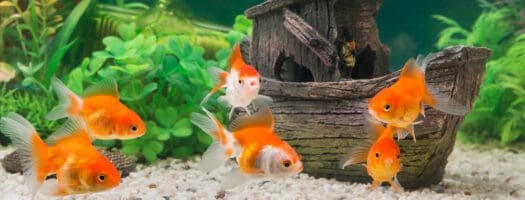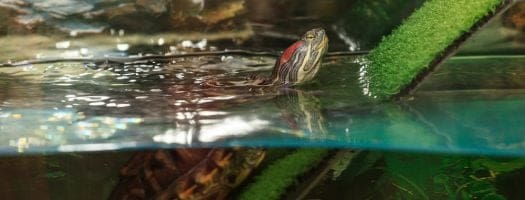The 10 Best Protein Skimmers to Buy in 2026
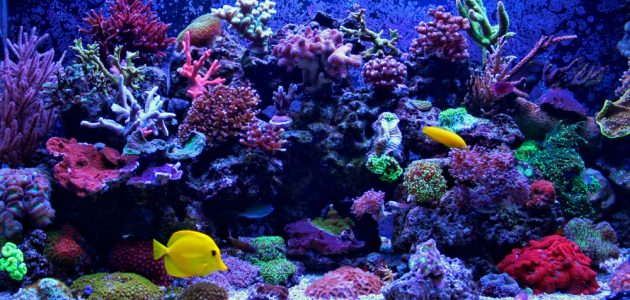
Every passionate aquarist knows the importance of maintaining good water quality in a tank. After all, if your aquatic pets don’t have a pristine marine environment to live in, they’ll struggle to survive, let alone thrive. For the proud owners of saltwater aquariums—be it one with coral or massive fish—installing a protein skimmer isn’t just a good idea; it’s a non-negotiable necessity.
The protein skimmer, which breaks down inorganic materials before they compromise the cleanliness of the water, is an essential piece of equipment for every high-end saltwater tank. Today we’re going to cover the best 10 protein skimmers on the market.
If you’d first like to learn more about protein skimmers and why you probably need one, skip ahead to our in-depth buyer’s guide.
- Before Picking a Protein Skimmer for Your Fish Tank
- Top 10 Best Protein Skimmers 2026
- 1. Best Overall Pick: Bubble Magus BM-Curve 5 Protein Skimmer
- 2. Best Premium Pick: Simplicity 240DC Protein Skimmer
- 3. Best Budget Pick: Macro Aqua M-50 Mini Hang-on Protein Skimmer
- 4. Best Low-Noise: S.C. Aquariums SCA-302 Protein Skimmer
- 5. Best Hang on Back Type Skimmer: Reef Octopus 100-HOB Protein Skimmer
- 6. Best for Nano Tanks: IceCap K1-Nano Protein Skimmer
- 7. Cleanest: AquaMaxx HOB-1.5 Hang on Back
- 8. Best Wheel Skimmer: Coral Vue Technology AC20287
- 9. Easiest to Use: Comline DOC Protein Skimmer 9001
- 10. Best High-Performance: NYOS Quantum 120 Protein Skimmer
- Protein Skimmer Buyer’s Guide
- Final Thoughts: The Best Protein Skimmers
Before Picking a Protein Skimmer for Your Fish Tank
Before you start sifting through our top recommendations, you must factor in the primary considerations when purchasing a protein skimmer for your tank. To help make the task a little easier, we’ve compiled a list of seven crucial things to consider below.
Installation Type
Protein skimmers come in three distinct installation types—hang on back (H.O.B.), in-sump, and in-tank—each of which includes a different sized tank and is placed in a different part of the tank. Jump to the Protein Skimmer Installation Types section of our buyer’s guide to get the lowdown on each.
Skimmer Type
Protein skimmers also come in four unique skimmer types—counter current, venturi, downdraft, and needle-wheel impeller—each of which operates differently. See our section on Protein Skimmer Types to learn more.
Capacity
Protein skimmers are rated at a maximum gallon capacity, which refers to the largest sized tank that can be serviced by a single unit. For optimal performance, choose a protein skimmer with a capacity that greatly exceeds your tank.
Dimensions
You’ve got limited space in your tank or sump, so be careful to pick a protein skimmer that fits inside. If you get an H.O.B. skimmer, you’ll still need to make sure there is enough room behind your tank to fit the unit. To make life easier, we include dimensions in all our reviews.
Noise
It’s no secret protein skimmers make a bit of noise, from a barely audible hum to a constant agitating buzz. If you’re easily annoyed by ambient noise or plan to install your set up in the bedroom, pay close attention to what our reviews say about the sound level.
Budget
Top of the line protein skimmers will set you back a pretty penny, so you must factor your financial situation into the decision-making process. Of course, for the avid aquarist, it’s hard to put a price on owning an immaculately clean tank.
Now that you have an idea of what to look for when shopping, here are our picks for protein skimmers to buy for your aquarium in 2026.
Top 10 Best Protein Skimmers 2026
1. Best Overall Pick: Bubble Magus BM-Curve 5 Protein Skimmer
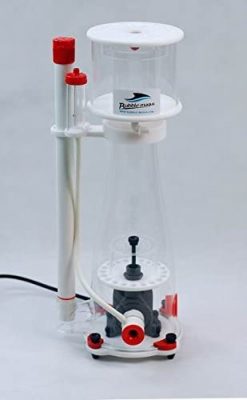
Editor’s Rating:
Why we like it: It’s quiet as a mouse and performs incredibly well for the price point.
Quick Facts:
- Tank Capacity: 140 gallons
- Installation Type: In-sump
- Skimmer Type: Needle-to-wheel impeller
- Dimensions: 26 x 9 x 10 inches; 5.51 pounds
Bubble Magus is famed for making a variety of high-quality saltwater aquarium products, and the BM-Curve 5 Protein Skimmer is one of the company’s crowning achievements. The awesome 140-gallon skimmer has developed a strong following in the industry for its efficiency, reliability, and low-noise operation—all of which come in at an affordable mid-range price.
The needle wheel pump on this aspirating impeller-style skimmer produces the perfect quantity and consistency of foam, while its in-built bubble plate does an outstanding job at reducing turbulence in the reaction chamber.
The “curve” in its name refers to the innovative shape of the device, which prompts foam to rise gently into the collection cup. This cup comes with a quick release for easy cleaning and a drain so you can let it filter into a reservoir.
It takes a bit longer to break in than other options on the market, but it’s worth the wait for a high-performing and unobtrusive skimmer that won’t send you broke.
Pros
- Reasonably priced
- High-performance impeller skimmer
- Innovative curved design
- Easy and infrequent cleaning
Cons
- Takes a while to break-in
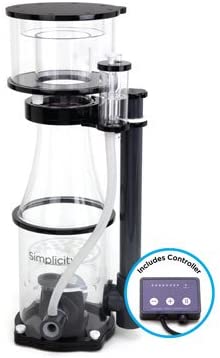
Editor’s Rating:
Why we like it: Put simply; the Simplicity 240DC is one of the most user-friendly, big-tank protein skimmers on the market.
Quick Facts:
- Tank Capacity: 240 gallons
- Installation Type: In-sump
- Skimmer Type: Needle-to-wheel impeller
- Dimensions: 8.3 x 7.9 x 19.5 inches; 8.5 pounds
It’s all in the name: the 240DC Protein Skimmer from Simplicity is simple to install and simple to use. The pint-sized in-sump skimmer features a cone-shaped design to funnel water into the large collection cup, which comes with a drain and a cap for easy cleaning.
Once you’ve set the desired water pressure on the included D.C. pump and adjusted the air intake, the system is ready to work its magic. The in-built needle wheel impeller does a brilliant job of slicing up bubbles into ultra-frothy foam, and the extended contact time between water and air ensures there’s always plenty going around.
The 240DC Protein Skimmer is smaller than the equivalent in sump options on the market, ideal for aquarists with limited sump space. It runs quiet, too, so you and your aquatic pets can finally enjoy some well-earned serenity at home.
Although it costs a bit more than other in sump skimmers on our list, the user-friendly design, powerful skimming capability, and quiet pump make this worth the investment in our book. You won’t get a user’s manual in the pack, but the system is simple enough not to need one.
Note that the 240DC Protein Skimmer performs better at higher water levels, so aim for nine inches or above if possible.
Pros
- Super easy to use
- Easy to clean and maintain
- Compact design
- Quiet
Cons
- Rather expensive
- Doesn’t include manual
- Doesn’t work well under 9 inches
3. Best Budget Pick: Macro Aqua M-50 Mini Hang-on Protein Skimmer

Editor’s Rating:
Why we like it: This tiny little skimming solution for smaller tanks packs one heck of a punch.
Quick Facts:
- Tank Capacity: 75 gallons
- Installation Type: Hang on back
- Skimmer Type: Needle-to-wheel impeller
- Dimensions: 5.5 x 5.5 x 13.5 inches; 2.15 pounds
Protein skimmers, as with other equipment in the aquarium industry, can set you back a sizable sum. But for casual enthusiasts with smaller tanks, there’s no need to spend a fortune as plenty of powerful yet cost-effective products are available on the market. The best of the budget bunch is the M-50 Mini Hang-on Protein Skimmer from Macro Aqua.
Coming in at well under a hundred bucks, the affordable unit brings protein skimming into the average aquarist’s home. Its petite frame fits neatly onto the back of smaller sized tanks and takes up very little room inside—perfect for when space is a precious commodity. What’s more, the needle-to-wheel impeller works well at increasing air to water contact, ensuring bubbles and clean-looking water are all but guaranteed.
It does take a while to get going, so you’ll need to be patient until the unit breaks in. Noise is a bit of an issue as well; give this one a pass if you’re a light sleeper or don’t like the thought of a constant hum.
Pros
- Small, compact design
- Perfect for little tanks
- Cost-effective
- Powerful needle-to-wheel impeller
Cons
- Rather noisy
- Takes a while to break-in
4. Best Low-Noise: S.C. Aquariums SCA-302 Protein Skimmer
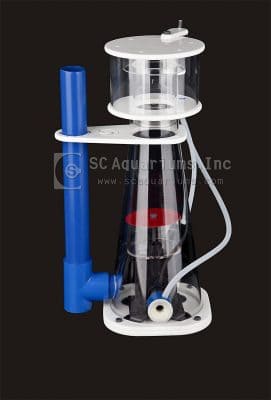
Quick Facts:
- Tank Capacity: 180 gallons
- Installation Type: In-sump
- Skimmer Type: Needle-to-wheel impeller
- Dimensions: 9 x 18 x 9.5 inches; 9 pounds
S.C. Aquariums are onto a winner with the SCA-302, a compact yet high-performance in-sump skimmer that pumps out massive bubbles with minimal noise to keep your tank impeccably clean.
At just 9 x 18 x 9.5 inches, it fits into most sumps where other skimmers won’t, making it the perfect option when you don’t want to compromise on performance. The in-built Atman 2000 needle impeller is to thank for its bubbling-making prowess, ensuring the unit is capable of cleansing even the most organic matter-rich tank. And unlike many competitors on the market, the unit is almost silent, so you can finally watch T.V. in the lounge room (or sleep in the bedroom) in peace.
Another thing we love about the SCA-302 is that the device works remarkably well straight out of the box. Within 12 hours, it’ll start bubbling away like mad, whereas some protein skimmers could take as long as 12 days to dial in fully.
On the downside, the collection cup can be a bit tricky to remove as you need to disconnect the silencer first—and considering how well this thing works, you’ll need to be taking it out often for cleaning. Furthermore, the instruction manual isn’t the best, although you should be able to find plenty of handy how-to videos online.
Finally, the included pump is prone to breaking down after heavy use, but at least S.C. Aquariums offers a one-year warranty as part of the deal.
Pros
- High-performance skimmer
- Doesn’t take long to break-in
- Runs almost totally silent
Cons
- Pumps tend to break down
- The instruction manual is confusing
- Removing the collection cup is tiresome
5. Best Hang on Back Type Skimmer: Reef Octopus 100-HOB Protein Skimmer

Editor’s Rating:
Why we like it: It works almost as well as an in-sump skimmer and doesn’t require much space behind the aquarium to install.
Quick Facts:
- Tank Capacity: 105 gallons
- Installation Type: Hang on back
- Skimmer Type: Needle-to-wheel impeller
- Dimensions: 19.49 x 10.51 x 9.41 inches; 8.55 pounds
If you don’t have a sump and you hate the thought of crowding out your aquarium with an in-tank skimmer, the best option is to get an H.O.B. model. The best H.O.B. protein skimmer on the market is the highly sought after 100-HOB from Reef Octopus.
The tiny little unit takes up minimal space behind your aquarium, so you won’t have to rearrange the whole house to cram it in. For something of such a small size, it pumps out quite a bit of power too, with a chunky Aquatrance 1000 pump and an active surface water degreasing function performing in unison to keep your tank crystal clear.
Our favorite feature, however, is its user-friendly design. Within seconds, you can adjust the extra-large collection cup to the precise level of skimming you’re after. The cup won’t overflow onto the floor either, as it’s designed to flow back down onto the skimmer when it’s full. Cleaning the unit is a breeze, as each portion easily comes apart for a quick freshwater soak (not that you’ll have to clean it all that often).
It takes a while to break in, but once you’ve got her going, you can pretty much set it and forget it.
Pros
- Compact design
- Powerful pump
- Surface water degreasing function
- Extra-large collection cup
- Easy to clean
Cons
- Takes a while to break-in
6. Best for Nano Tanks: IceCap K1-Nano Protein Skimmer

Quick Facts:
- Tank Capacity: 30 gallons
- Installation Type: In-sump
- Skimmer Type: Downdraft
- Dimensions: 3.94 x 5.91 x 15.75 inches; 2.43 pounds
If you’re rocking a marine life-rich nano tank in the living room, you need a suitably sized protein skimmer that doesn’t take up much room and won’t make a lot of noise. And that’s precisely where the K1-Nano Protein Skimmer from IceCap excels—compact and quiet skimming with non-stop bubbles.
The super small skimmer has a footprint of only a few inches, so you won’t sacrifice much space in your nano to run it. Inside the turbulence reducing body, there’s a pipe-free output valve in the bubble dispersant chamber to reduce ambient noise. And the icing on the cake? You can easily disassemble the entire unit for easy cleaning.
A magnet mount lets you position the skimmer on any surface up to ½ an inch thick, while the connected DC Cair 200 skimmer pump provides impressive performance.
Just be aware that the cap on the top isn’t quite tight enough and could fall off during the break-in process, potentially spilling all over your previously pristine carpet.
Pros
- Perfect for nano tanks
- Extremely quiet
- Compact design
- Magnetic mount
- Powerful pump
Cons
- Cap may fall off and cause flooding
- Not powerful enough for larger tanks
7. Cleanest: AquaMaxx HOB-1.5 Hang on Back
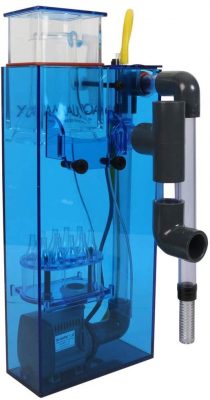
Editor’s Rating:
Why we like it: This user-friendly and high-performance H.O.B. skimmer is well worth the additional expense.
Quick Facts:
- Tank Capacity: 90 gallons
- Installation Type: Hang on back
- Skimmer Type: Needle-to-wheel impeller
- Dimensions: 5 x 3.5 x 17 inches; 7.8 pounds
You’ll pay a bit more for the privilege, but the AquaMaxx HOB-1.5 is a sensible investment for keen aquarists who want to clean their tank the best they possibly can. This upgraded version of the older 1.0 model boasts better-than-ever bubble creation due to its heavy-duty diffuser, high-tech reaction chamber, and powerful Shark Pump, a trio of carefully engineered components that result in endless amounts of foam.
As a result, you’ll pull handfuls of organic matter out of the collection cup in your very first cleanse, and the entire set up is simple to use by adjusting the height of the cup. To make life easier, the removable collection cup can be fitted with a drain to draw the skimmate away into a separate reservoir, in which case you’ll rarely have to empty it out.
Another massive plus of this model is its compact design, as the Italian-made Sicce pumps sit inside the skimmer to save on aquarium real estate. As a neat little byproduct, this approach also reduces the noise level of the pump, making it among the quietest skimmers on the market today.
Unlike most H.O.B. units, the AquaMaxx HOB-1.5 has a tube that feeds back into the tank to prevent spillage, although it does tend to make a bit of a gurgling sound when in use (better than wet carpet, though).
Just be aware that it doesn’t work on tanks higher than 11 inches tall or ¾ thick.
Pros
- High-performance H.O.B. skimmer
- Pump sits inside skimmer for quiet operation
- Small and compact
Cons
- Rather expensive
- Doesn’t work on tall or thick tanks
8. Best Wheel Skimmer: Coral Vue Technology AC20287
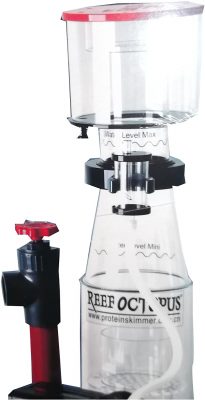
Editor’s Rating:
Why we like it: This no-nonsense needle wheel-style protein skimmer is an aquarium cleansing powerhouse.
Quick Facts:
- Tank Capacity: 210 gallons
- Installation Type: In sump
- Skimmer Type: Needle-to-wheel impeller
- Dimensions: 12 x 15 inches
It might not be the cheapest, quietest, or most compact protein skimmer on the market, but there’s one area where the AC20287 Octopus excels: filtering organic matter from water. A workhorse OTP pump combined with Coral Vue Technology’s latest pinwheel impeller skimmer create boatloads of tiny foamy bubbles, enough to cleanse even the murkiest, most toxin-filled tank.
It’s easy to maintain and clean as well, as the four-inch cone-shaped neck directs gunk straight into the extensive collection cup, which slides out effortlessly thanks to a quick-release valve. Water level adjustment is easy with the gate valve, and the system boasts impressive performance on tanks up to 210 gallons, even within the first 24 hours.
The device is quite a bit larger than other in-sump models; you’ll need to have space for a depth of 6-8 inches to operate the machine. But for serious aquarists, the extra bulk is a worthy compromise for the high-performance skimming that the Octopus entails.
We did come across one minor design flaw: the plastic nipple in the drain hose has a tendency to break. It’s not a huge issue, however, as you can continue to use the drain, albeit with a little fiddling around.
Pros
- Powerful pump
- High-tech needle wheel skimmer
- Excellent performance
- Breaks-in quickly
Cons
- Slightly above average cost
- Larger than most in-sump skimmers
- Drain hose nipple is flimsy
9. Easiest to Use: Comline DOC Protein Skimmer 9001
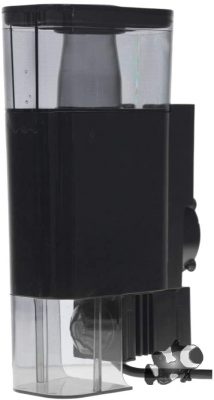
Editor’s Rating:
Why we like it: A cost-effective and quiet skimmer specially designed for tiny nano tanks.
Quick Facts:
- Tank Capacity: 37 gallons
- Installation Type: In sump
- Skimmer Type: Needle-to-wheel impeller
- Dimensions: 3 x 2.5 x 8.5 inches; 1.85 pounds
Nano tank owners who need a simple and affordable skimming solution will love the Comline DOC 9001 from Tunze. While most nano tank saltwater skimmers require lots of fiddling about to dial in, the Comline DOC 9001 has an easy-to-understand, “plug and play” design that’s simple enough for the complete novice to comprehend. There’s virtually no time-consuming setup or configuration process required here—all you need to do is install it and switch it on.
The device works well in tanks up to 37 gallons and requires a minimum of 6 inches of water to operate effectively. Once you’ve popped the lid on, its super quiet, perfect for aquarists in search of peaceful respite.
One thing we definitely don’t like, however, is the poorly designed magnetic mount. The square plastic tabs in use just don’t connect properly to the holes, which makes the mount flimsy and prone to wiggling about. Sure, you could try fixing it up yourself with epoxy putty or the like, but you really shouldn’t have to.
You’ll also need to ensure the water level of the tank is just right; otherwise, you’ll flood the skimmer and have an icky organic matter-fuelled clean up on your hands.
Pros
- Easy to use and maintain
- Works in just six inches of water
- Compact design suitable for nano tanks
- Quiet operation
Cons
- The magnetic mount is poorly designed
- Tends to flood more quickly than others
10. Best High-Performance: NYOS Quantum 120 Protein Skimmer
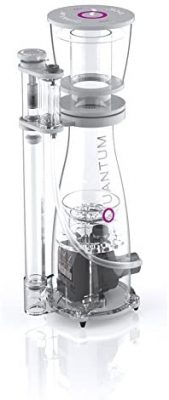
Editor’s Rating:
Why we like it: A high-performance impeller and soft humming pump make this product one to consider for high-budget aquarists.
Quick Facts:
- Tank Capacity: 130 gallons
- Installation Type: In sump
- Skimmer Type: Needle-wheel impeller
- Dimensions: 25.6 x 10 x 8.5 inches; 7.1 pounds
Most of the top protein skimmers on the market come in at around the $200, so a product would have to be pretty impressive to command almost double that amount. So is the NYOS Quantum 120 worth those two extra Benjamins?
Perhaps, but only if you’re flush with cash.
The Quantum 120 performs well compared to lower-end models, creating a perfect mixture of air and water for optimal, organic matter-cleansing foam. The machine is also exceptionally quiet, at least when installed and set up correctly at the proper water level height.
Plus, it draws a minuscule amount of power compared to other high wattage skimmers out there, which will help you recoup some of your investment via lower power bills. And finally, the machine is famously reliable and easy to maintain, allowing you to sit back and relax without stressing over cleaning duties or repairs (it’s easy enough to pull apart when you need to, anyway).
But while these outstanding qualities do make it a significant step up from the competition, they don’t necessarily justify the price.
If you’re in a strong financial position and don’t mind forking out for a top-end machine, then knock yourself out. Though if you’re keeping close tabs on your budget during these trying economic times, it’s probably worth giving this one a miss and opting for a mid-range model—they offer comparable performance for a substantially lower price, after all.
Pros
- High-performance impeller skimmer
- Reliable and easy to maintain
- Draws minimal power
- Quiet operation
Cons
- Extremely expensive
- Isn’t much better than mid-range skimmers
Protein Skimmer Buyer’s Guide
If you’re feeling a bit bewildered by the protein skimmer and are struggling to comprehend what you need to purchase and why, you’ve come to the right place. In this in-depth buyer’s guide, we’ll explain exactly what a protein skimmer is, how it works, who should buy one, and its primary benefits.
We’ll also cover the different types of skimmers and provide information on installing and maintaining the device, as well as a lengthy F.A.Q.
The Protein Skimmer Explained
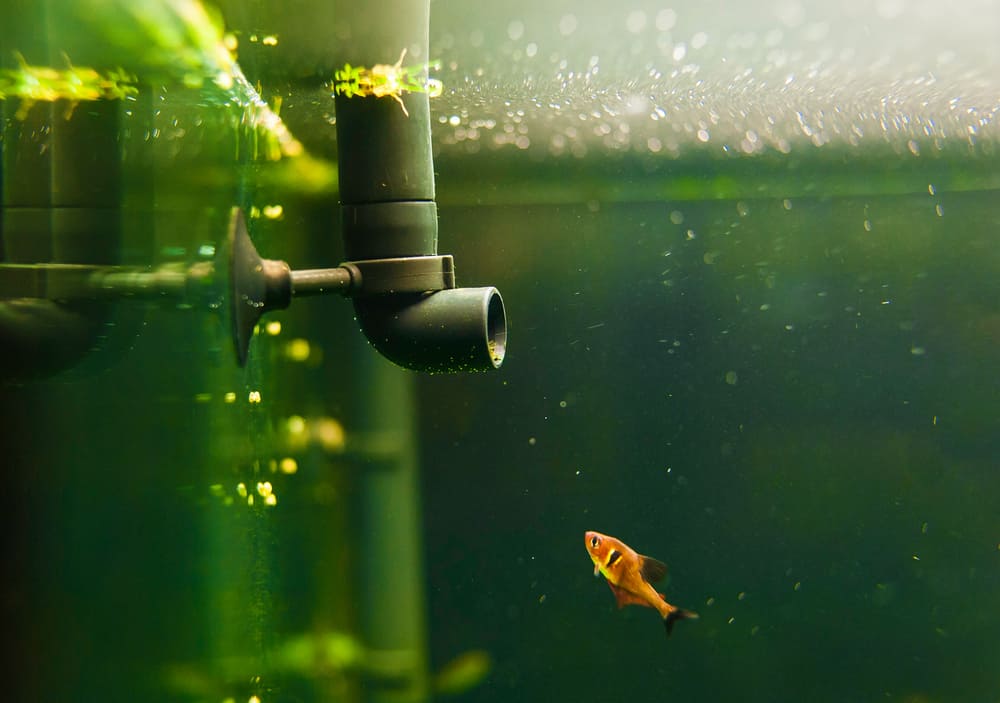
The protein skimmer is a kind of mechanical filter that removes unwanted organic material from your aquarium. These compounds, which include toxins, bacteria, waste products, and chunks of uneaten fish food, will eventually break down and ruin the water quality of your tank through excessive nitrate and ammonia content as well as algae growth.
Therefore, installing an effective protein filter will safeguard the health and well-being of your beloved marine animals. And as a neat little bonus, you’ll enjoy clearer and cleaner looking water as well.
How a Protein Skimmer Works
The device is called a “protein skimmer” because it uses a process known as the “polarity of proteins” to remove organic compounds from a water source. The process works via a reaction chamber that creates lots of tiny little bubbles, which the protein particles of nearby organic compounds fuse onto and float to the surface. Once there, the organic matter is filtered through a collection cup.
The best protein skimmers enhance the process by using a needle wheel impeller, A.K.A a pinwheel, to cut the bubbles into smaller bubbles, thus improving the polarity of proteins process.
Who Should Buy a Protein Skimmer
Novice aquarists might ask themselves: “Do I really need a protein skimmer for my tank?” While protein skimmers can help maintain a clean and healthy living environment for your beloved aquatic pets, they’re not a necessity for every aquarium.
Basic freshwater setups with common species of fish don’t require a protein skimmer, strictly speaking. It’ll still help keep the water clean and clear, but most freshwater fish and invertebrates can withstand the low nitrate levels that result from having organic matter floating around in the tank.
Saltwater tanks, on the other hand, absolutely do need a protein skimmer installed, especially once coral comes into the equation. Even minute levels of ammonia and nitrates will put a tremendous amount of stress on most marine species, eventually causing them to go belly up.
The Benefits of Installing a Protein Skimmer
Still unsure whether a protein skimmer is a worthwhile investment for your aquarium? Let’s take a look at some of the key advantages of getting one installed.
Protein Skimmers Lower Nitrate and Ammonia Levels
The main aim of a protein skimmer is to prevent the build-up of ammonia and nitrates caused by floating organic compounds, which can be deadly to larger fish (especially saltwater species) and coral.
Protein Skimmers Reduce Maintenance
As protein skimmers inhibit the growth of algae, you’ll spend less time trying to clean the green muck out. And as you’ll have less algae climbing the glass walls of your tank, you’ll enjoy a better view of your beautiful marine creatures.
Protein Skimmers Cleanse the Water
As a protein skimmer uses bubbles to push organic material to the surface, you’ll be left with lovely crystal clear water in the tank. No more stressing about leftover food flakes and fish waste floating around in the water.
Installing Your Protein Skimmer
Protein skimmers can be installed in three different ways, each of which is intended for a specific size or shape of tank. Choosing the correct type of protein skimmer is essential; otherwise, it simply won’t work on your set up.
Hang on Back (H.O.B.)
As you’ve probably inferred from the name, hang on back (commonly known as H.O.B.) protein skimmers are built to hang off the back end of your tank, which is perfect for setups that don’t have a sump. Note that H.O.B. protein skimmers are suitable for smaller tanks under a 100-gallon capacity, including nano tanks.
The system is positioned on the back rim of the tank, in much the same way you would install a power filter.
In-Sump
In-sump protein skimmers are designed to operate within the sump, a special filter primarily used for reef or marine aquariums. In-sump filters vary significantly in price, size, and features, with the more advanced models used in state-of-the-art aquariums for public display.
Smaller and more affordable in-sump protein skimmers cater to domestic and hobby aquarists.
In-Tank
In-tank protein skimmers are the smallest of the lot, typically designed for use inside nano tanks. Although they aren’t nearly as powerful as the abovementioned options, in-tank skimmers do an excellent job at cleaning smaller tanks with a modest amount of floating organic matter.
As you’d expect, in-tank skimmers do not require a sump to operate. As they take up precious room inside the tank, we recommend opting for an H.O.B. or in-sump skimmer instead.
Protein Skimmer Types
Regardless of how the device is installed, the skimmer itself will come in one of four varieties, each of which has its own distinct pros and cons.
Needle Wheel Impeller Skimmers
Needle Wheel (A.K.A impeller) skimmers are widely regarded as the crème de la crème of the protein skimmer industry, offering the most effective method of filtering out the contaminants of your tank. The skimmer directs air towards the impeller (the rotating component of a centrifugal pump) to create bubbles. The impeller has a tiny needle wheel that slices the air bubbles up to make even smaller bubbles, thus enhancing the effectiveness of the polarity generated
Impeller skimmers are easy to run as they don’t require a powerful pump to operate. However, they do tend to break down more often than other skimmer types, so if you’re not prepared to monitor the status of your aquarium, you might want to give these a pass.
Nonetheless, impeller skimmers are easily the most potent and popular option in the modern age, which is why we recommend these almost exclusively on our list.
Countercurrent Skimmers
The old school countercurrent skimmers use wooden air defuses and a heavy-duty air pump to produce large volumes of foam, thus optimizing the polarity of the process of the protein.
On the downside, they require quite a bit more maintenance than other skimmer types. Firstly, you’ll need to regularly switch out the air stones, perhaps as often as every two months if there’s a large amount of organic material in your tank. You’ll also need to monitor and repair the air pump diaphragms (rubber seals), as the system will stop functionally completely should they fail.
Countercurrent skimmers are somewhat outdated these days, now rather redundant thanks to the impeller needle wheel.
Venturi Skimmers
These use a mechanism called a “venturi injector” to create a large volume of air bubbles, which makes them a popular option for aquarists with high filtration needs. Although they’re small in size, you’ll need a powerful pump for these skimmers to function at their peak.
The best venturi skimmers come with a special spray head design that increases the volume of air in the water, thus resulting in more bubbles (and a cleaner tank). Venturi skimmers are generally favored by the owners of large scale operations like fish farms and public aquariums.
Downdraft Skimmers
Downdraft skimmers function by using a jet to spray water at a high velocity into a series of bio balls within a column. As the bubbles pass through the bio ball column, they enter into the sump, which deflects them in an upward motion to create foam.
The process requires water to be pushed further than most other skimmer types as it needs to pass through the column before bubbles can appear. Therefore, you’ll need a bigger pump to operate the system, and the skimmer tends to be bigger overall.
Installing a Protein Skimmer
Most protein skimmers intended for domestic use are designed to be easily installed by the ‘Average Joe’ with no specialist skills. Because every protein skimmer is different, the easiest way to work out how to set yours up is by consulting the instruction manual.
If you’ve lost your manual (or can’t understand it), try searching YouTube for instructional videos. The most popular protein skimmers all have at least one tutorial to guide you through the installation and maintenance process.
Maintaining a Protein Skimmer
A decent protein skimmer from a reputable brand, such as those we recommend on our top 10 list, will usually work without breaking down.
Nonetheless, the aquarist does need to perform periodic maintenance in terms of manually cleaning out the collection cup. If you’re the kind of person who might forget to carry out this essential task, then opt for a protein skimmer with a larger collection cup, as these can be emptied less often. Better yet, go with a model that has a collection cup drainer, which automatically siphons the organic gunk into a separate reservoir.
We recommend doing a more in-depth maintenance every six months or so, which involves disassembling the unit and cleaning all its components. Aim to replace rather than clean the plastic tubing, as it always starts to degrade after a while.
You can clean the parts by soaking them in hot water for an hour, then gently scrubbing them with a soft brush. Rinse each piece again before reassembling the unit.
Protein Skimmer F.A.Q.
If you’ve made it this far and still have questions about the protein skimmer, there’s a good chance you’ll find them below.
Do Protein Skimmers Remove Nitrates?
A common misconception is that a protein skimmer will remove nitrate from the water. However, that’s not exactly the case. Instead, the tiny bubbles lift organic material to the surface before they break down into nitrates.
Therefore, it would be more accurate to say protein skimmers prevent the accumulation of nitrates.
Do Protein Skimmers Remove Phosphates?
Not exactly.
Reactive phosphates stimulate algae growth, while inorganic phosphates interfere with coral growth by inhibiting the formation of a healthy calcium carbonate skeleton. Protein skimmers can’t remove either type from your system, but they can prevent them from accumulating by reducing the level of organic compounds in the water. Many organic materials contain phosphorous, which breaks down into phosphate.
Therefore, as is the case with nitrates, a protein skimmer can help prevent the build-up of phosphates.
Do Protein Skimmers Remove Ammonia?
Protein skimmers won’t remove ammonia from the water in your tank, but they can prevent it from accumulating in the first place.
Uneaten fish food and solid waste will eventually decompose into ammonia after being broken down by bacteria. Removing these organic elements from the water before this decomposition occurs will stop the ammonia content in your water from increasing.
Will a Protein Skimmer Help With Algae?
Yes.
Algae needs to feast on nutrients such as nitrogen and phosphorous to survive. Organic compounds floating in the water will slowly release these nutrients over time, thus allowing the algae to bloom.
Prohibiting the build-up of organic material in the water via a protein skimmer will starve algae of their food source and significantly inhibit their growth. Although a protein skimmer won’t totally remove algae from your aquarium, it will help bring the problem under control.
Should I Run My Protein Skimmer All the Time?
Yes.
Because coral, fish, algae, and bacteria are constantly releasing organic matter into the water, you’ll need to leave your protein skimmer on 24/7 to compensate.
Letting the skimmer run continuously will remove organic material as soon as it enters the water and, therefore, reduce the level of ammonia, nitrates, and phosphates in your tank—all of which are bad for marine animals. Switching it off periodically will allow these elements to accumulate and compromise the well-being of your pets.
Are Protein Skimmers Noisy?
Protein skimmers do make a faint humming sound, which can be annoying when it’s located in the bedroom, and you’re trying to sleep. To rectify the issue, you could try placing a foam matt under the skimmer to reduce the noise-emitting vibrations. Also, check all the parts of the pump are working correctly, as these can make an awful racket when damaged.
Loud gurgling or splashing sounds aren’t normal, however, and can usually be fixed. Try tweaking with the airflow or putting a foam block underneath to reduce the splashing sound.
Why Is My Protein Skimmer Overflowing?
Some protein skimmers tend to foam up and overflow, especially if not configured correctly. Consult your instruction manual to learn the proper way to set up the device.
Overflowing often occurs when the skimmer collection cup is too low. Moving the cup up higher may cause the foam to become fluffier and drier as it forces the excess water to drain away.
You could also try turning down the air adjustment valve. It won’t have an immediate effect, so come back in 15 minutes to see whether that has helped. If necessary, turn it down a little more and reassess again.
Why Isn’t My Protein Skimmer Creating Foam?
If you’ve just set up a brand new protein skimmer in your tank, you’ll need to wait for a while for the system to “break-in.” The process generally takes a few days, by which time you should start seeing foam bubbles appear. Once it’s started working correctly, you can begin fine-tuning (dialing in) the settings if required.
Note that the amount of foam produced isn’t constant—skimmers in clean tanks will make minimal foam, while those in tanks with a high level of organic content create huge spurts. A recently deceased fish or a large-scale algae die-off will cause an increase in the organic matter content of your tank and lead to more active bubbles.
Do Protein Skimmers Oxygenate Water?
Yes, to an extent.
Protein skimmers create micro-bubbles, which enhance the level of oxygen as they agitate the surface of the water. Note that the degree of oxygenation is relatively low compared to a pump, which circulates water throughout the entire system.
Why Aren’t Protein Skimmers Very Effective in Freshwater?
Protein skimmers work by creating microbubbles that latch on to organic matter and draw it to the surface. In saltwater, dissolved organic matter creates a stable and semi-rigid structure around the bubbles, which we call “skimmate” foam.
In freshwater, however, a difference in surface tension between the water and the organics inhibits this process, which makes protein skimmers far less effective. For this reason, aquarists generally don’t bother using skimmers in freshwater unless there’s a higher-than-usual density of organic matter, such as in fish farms or crowded public aquariums. To clean out unwanted organic compounds in freshwater, most people opt for a frequent water change instead.
Final Thoughts: The Best Protein Skimmers
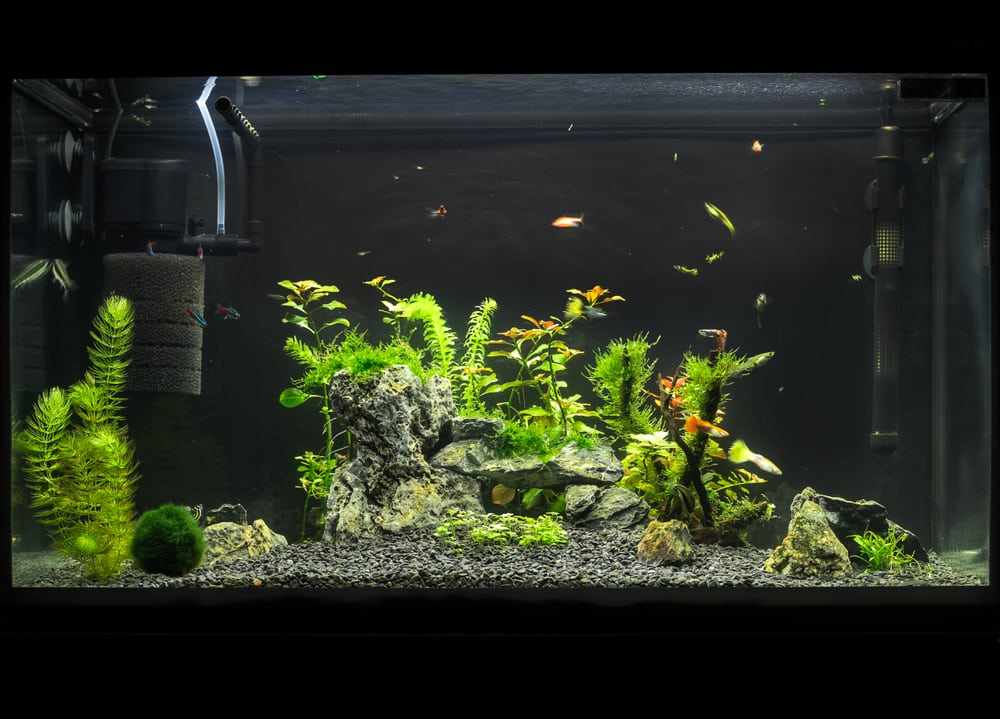
Now that you’re a verified protein skimmer expert, it’s time to peruse our recommendations and purchase one for your aquarium. Remember to factor in our top considerations to determine what features are most important to you.
With the right protein skimmer in place, you’ll be able to reduce toxins and create a healthy environment for your adorable aquatic pets to thrive. Couple that with crystal clear water and a distinct absence of algae, and it’s easy to see why a quality protein skimmer is a worthy investment for every avid aquarist.
